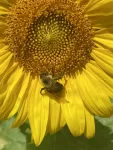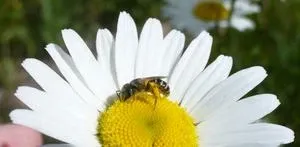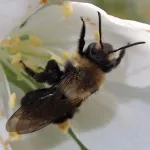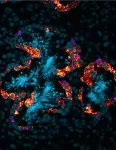(Press-News.org) As critical pollinators, bees keep our agricultural systems going — but human-caused changes to the planet heavily impact their foraging options. To help protect our food security, we need more information about bees’ own dietary requirements. Scientists writing in Frontiers in Sustainable Food Systems studied the nutritional value of 57 types of pollen and found that bees need to forage from a variety of plants to balance their diet between fatty acids and essential amino acids.
“Despite public interest and a rise in pollinator plantings, little is known about which plant species are best suited for bee health,” said Dr Sandra Rehan of York University, senior author. “This study aimed to better understand the nutritional value of plant species. Based on their ideal protein to lipid ratios for wild bee nutrition, we recommend that pollen species from roses, clovers, red raspberry, and tall buttercup should be emphasized in wildflower restoration projects.”
The bees’ needs
Pollen and bees are heavily interdependent: plants need bees to spread their pollen to reproduce, and bees need pollen to eat. While bees get their carbohydrates from nectar, pollen provides proteins, lipids, and other critical nutrients. Anthropic changes to the environment which alter the availability and the properties of pollen risk malnourished bees.
Bees especially need to consume high-quality foods containing non-esterified fatty acids like omega-6 and omega-3. Without these nutrients, bees live shorter lives, have weaker immune systems, and are less able to cope with environmental stressors — but if bees consume them in the wrong ratio, they experience cognitive problems. Bees also need essential amino acids, which are necessary for cognitive health and reproduction — but if they eat too much, they may be more susceptible to certain parasites.
To understand which plants are best for bees, the scientists collected pollen samples from 57 species found in North America, either from fresh flowers in the wild or from flowers dried in the lab. They chose the plant species based on their importance to species of wild northeastern bee and their prevalence. The pollen was processed and analyzed for levels of different amino acids, non-esterified fatty acids, and protein to lipid and omega-6:3 ratios, to determine which plants were best for bees.
The scientists also investigated whether closely related species of plant provided similar nutritional benefits, and whether species that had been introduced to the area where they were collected were less nutritious than endemic species.
Healthy eating habits
In general, plants from the same family offered bees quite different nutrients compared to other members of the same family, with the exception of essential amino acids. Plants from the cabbage family, the legume family, and the daisy family all had similar levels of essential amino acids compared to other plants within the same family. Daisies, a very important plant for foraging bees, boasted particularly high levels of essential amino acids. Interestingly, plants that were high in essential amino acids were relatively low in non-esterified fatty acids, and vice versa.
“There is a potential tradeoff between fatty acid and amino acid content within pollen, suggesting that a diverse floral diet may benefit bees more than a single pollen source,” said Rehan. “No one plant species is optimal for generalist wild bee health.”
The scientists’ results indicated that feeding from many different flowers is best for most bees, and that feeding from endemic species of plant offers no nutritional advantage. Most pollen species contain most of the necessary nutrients, but to get the optimal levels of nutrients in their diets, bees would need to forage from several different plant species. The scientists suggested that this diversity of nutritional content reflects the diverse needs of different species of bees, especially the specialist species that favor particular plants. A wide variety of sources of nutrition with different properties means that all bees can forage on the plants that feed them best.
“We hope this work will help inform flowering plant selections for pollinator gardens,” said Rehan. “But here we examined only 57 plant species, and there are thousands to examine to understand nutritional profiles. We hope this will inspire future similar research as well as follow up studies on the preference and survival of bees on different diets.”
END
The plants you need to keep bees on a healthy diet have been revealed
To protect wild bees for the future, scientists identified which plants we can grow to give them a complete, healthy diet
2024-06-26
ELSE PRESS RELEASES FROM THIS DATE:
"A hearty debate" concludes plant-based meat alternatives are healthier for your heart than meat
2024-06-26
Even though there is substantial variability in the contents and nutritional profiles of plant-based meat alternatives (PBMAs), the nutritional profiles tend to reflect a heart-healthy dietary pattern. A review article appearing in the Canadian Journal of Cardiology, published by Elsevier, of the available studies directly comparing the impact of plant-based and animal-based meats consistently suggests that the plant-based alternatives improve cardiovascular risk factors.
PBMAs are highly processed plant-based food products that typically replace meat in the diet. ...
Convolutional optical neural networks herald a new era for AI imaging
2024-06-26
Convolutional Neural Networks (CNNs), with its exceptional image recognition capabilities, have performed outstandingly in the field of AI and notably within platforms like ChatGPT. Recently, a team of Chinese researchers from University of Shanghai for Science and Technology have successfully introduced the concept of CNNs into the field of optics and realized convolutional all-optical neural network, bringing revolutionary progress to AI imaging technology.
Led by Prof. Min Gu and Prof. Qiming Zhang from School of Artificial Intelligence Science and Technology (SAIST) at the University of Shanghai for Science and Technology ...
Molecular mapping reveals tissue-specific gene regulation by diabetes-linked transcription factors
2024-06-26
SINGAPORE — Scientists have generated a comprehensive map of the gene targets regulated by the transcription factors HNF4A and HNF1A in human pancreatic beta cells and liver cells. Published in the journal Nature Communications, the study revealed common and tissue-specific molecular pathways regulated by HNF4A and HNF1A, two proteins that possess important functions governing the development and function of the pancreas and liver.
Notably, the scientists identified several novel gene targets in pancreatic beta cells, the cells responsible for insulin ...
Wildfires increasingly threaten oil and gas drill sites, compounding potential health risks, study says
2024-06-26
More than 100,000 oil and gas wells across the western U.S. are in areas burned by wildfires in recent decades, a new study has found, and some 3 million people live next to wells that in the future could be in the path of fires worsened by climate change.
Researchers from the University of California, Berkeley, said their analysis, which was published last week in the journal One Earth, is the first to examine historical and projected wildfire threats on oil and gas facilities in the U.S. While the public health effects of scorched and damaged drill sites are unclear, researchers said the study is a necessary step ...
Gender gaps in cardiovascular disease diagnosis and treatment persist; $28 billion opportunity found
2024-06-26
DALLAS, JUNE 25, 2024 — Cardiovascular disease is the leading cause of death for women, and gaps in care and access persist between women and men. Addressing those gaps could lead to an increase of at least 1.6 million years of quality life and boost the U.S. economy by $28 billion annually by 2040, according to a new report published today by the American Heart Association and the McKinsey Health Institute (MHI). To help close these gaps and foster gender specific cardiovascular disease science into implementation, the Association, observing 100 years of lifesaving service as the world’s leading nonprofit organization ...
Researchers propose the next platform for brain-inspired computing
2024-06-26
(Santa Barbara, Calif.) — Computers have come so far in terms of their power and potential, rivaling and even eclipsing human brains in their ability to store and crunch data, make predictions and communicate. But there is one domain where human brains continue to dominate: energy efficiency.
“The most efficient computers are still approximately four orders of magnitude — that’s 10,000 times — higher in energy requirements compared to the human brain for specific tasks such as image processing and recognition, although they outperform the brain in tasks like mathematical calculations,” said UC Santa Barbara ...
Following the ‘BATT Signal:’ A new signaling pathway controlling planarian germ cells
2024-06-25
Biogenic monoamines — molecules like dopamine and serotonin — are famous for their role as the brain’s emissaries of mood, learning and memory, stress mechanisms, and fight-or-flight responses in the body.
But these neurotransmitters existed in nature long before brains popped up in the evolutionary tree. They’re prevalent in plants, bacteria, and single-cell organisms as well, but their functions there are far less understood.
Scientists at the Morgridge Institute for Research have added another task for ...
For many urban residents, it’s even hotter than their weather app says
2024-06-25
DURHAM, N.C. -- There’s a strong chance that last week’s scorching temperatures were even hotter than reported for those living in underserved urban areas.
It’s been well established that more impoverished areas within cities are typically hotter than their wealthier neighborhoods. Dubbed “urban heat islands,” these communities have more buildings, less vegetation and somewhat higher population density, which combine to produce the heating effect.
New research from environmental engineers at Duke University has shown that citizen science tools used to gauge heat in these ...
Bladder buzz: technologies to improve bladder surgery and monitoring
2024-06-25
A functional, healthy bladder is something that many of us take for granted. Yet millions of Americans deal with bladder issues, ranging from temporary inconveniences to long-lasting conditions. While many bladder disorders can be managed with non-invasive solutions, some conditions may require surgery to restore bladder function.
In patients with major bladder issues, a cystectomy may need to be performed. In this procedure, some or all of the bladder is removed (reasons for this may include acute trauma or bladder cancer). Sometimes, to compensate for the loss of tissue, the bladder is augmented (made larger), typically with ...
Half of world’s lakes are less resilient to disturbance than they used to be
2024-06-25
American Geophysical Union
Press Release 24-27
For Immediate Release
25 June 2024
This press release is available online at: https://news.agu.org/press-release/worlds-lakes-less-resilient-climate-pollution/
AGU press contact:
Rebecca Dzombak, news@agu.org (UTC-4 hours)
Contact information for the researchers:
Ke Zhang, Chinese Academy of Sciences, kzhang@niglas.ac.cn (UTC+8 hours)
WASHINGTON — Nearly half of the world’s large lakes have lost resilience, or the ability to bounce back after an abrupt disturbance, in recent ...
LAST 30 PRESS RELEASES:
New design playbook could unlock next generation high energy lithium ion batteries
Drones reveal how feral horse units keep boundaries
New AI tool removes bottleneck in animal movement analysis
Bubble netting knowledge spread by immigrant humpback whales
Discovery of bats remarkable navigation strategy revealed in new study
Urban tributaries identified as major sources of plastic chemical pollution in the Yangtze River
UK glaucoma cases higher than expected and projected to reach 1.6 million+ by 2060
Type 2 diabetes prevention could more than halve carbon footprint linked to disease complications
Over 1 million estimated to have glaucoma in UK
Early treatment can delay rheumatoid arthritis for years
National childhood type 1 diabetes screening is effective and could prevent thousands of emergency diagnoses, UK study shows
Mix of different types of physical activity may be best for longer life
Continuous care from community-based midwives reduces risk of preterm birth by 45%
Otago experts propose fiber as first new essential nutrient in 50 years
Auburn Physics PhD student earns prestigious DOE Fellowship
AI tool helps you learn how autistic communication works
To show LGBTQ+ support, look beyond Pride Month
Using artificial intelligence to understand how emotions are formed
Exposure to wildfire smoke late in pregnancy may raise autism risk in children
Breaking barriers in lymphatic imaging: Rice’s SynthX Center leads up to $18 million effort for ‘unprecedented resolution and safety’
Dhaval Jadav joins the SETI Institute Board to help spearhead novel science and technology approaches in the search for extraterrestrial life
Political writing retains an important and complex role in the national conversation, new book shows
Weill Cornell Medicine receives funding to develop diagnostic toolbox for lymphatic disease
It started with a cat: How 100 years of quantum weirdness powers today’s tech
McGill researchers identify a range of unexpected chemical contaminants in human milk
Physical therapy research highlights arthritis’ toll on the workforce — and the path forward
Biomedical and life science articles by female researchers spend longer under review
Forgetting in infants can be prevented in mice by blocking their brain’s immune cells
Blocking immune cells in the brain can prevent infant forgetting
AI-driven ultrafast spectrometer-on-a-chip: A revolution in real-time sensing
[Press-News.org] The plants you need to keep bees on a healthy diet have been revealedTo protect wild bees for the future, scientists identified which plants we can grow to give them a complete, healthy diet






